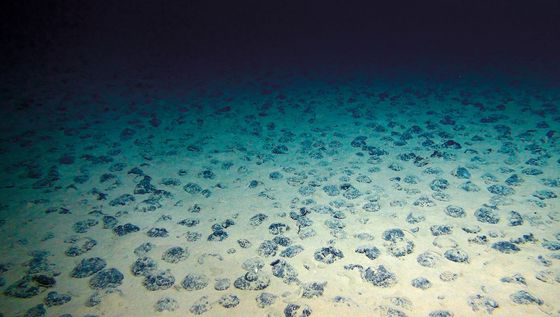| |
| Research supported by GEOMAR questions the origins of life and calls for further research on oxygen production in the deep sea |
| |
A discovery in the dark depths of the Pacific Ocean is challenging the scientific consensus of how oxygen is produced and has even called into question how life on Earth began. In a study now published in the scientific journal Nature Geoscience, a team of authors led by the Scottish Association for Marine Science (SAMS) shows that oxygen is formed in complete darkness at the seafloor 4,000 meters below the ocean surface. They hypothesize that seawater electrolysis may contribute to this “dark oxygen” production. Expertise on specific sensors provided by GEOMAR Helmholtz Centre for Ocean Research Kiel, Germany, helped to investigate the phenomenon which stands in surprising contrast to the established fact that oxygen is usually produced by photosynthetic organisms using energy from sunlight.
The discovery was made while sampling the seabed of the Clarion-Clipperton Zone to assess the possible impacts of deep-sea mining. This process would extract polymetallic nodules that contain metals such as manganese, nickel and cobalt, which may help to address the growing demand required to produce lithium-ion batteries for electric vehicles and mobile phones. The researchers found nodules to be carrying a very high electric charge, which could lead to the splitting of seawater into hydrogen and oxygen in a process called seawater electrolysis. Only a voltage of 1.5 Volt is needed for seawater electrolysis to occur – the same voltage as a typical AA battery. The team analyzed multiple nodules and recorded readings of up to 0.95 volts on the surfaces of some, meaning that significant voltages can occur when the nodules are clustered together.
The researchers first thought their sensors were faulty, because every study ever done in the deep sea has only seen oxygen being consumed rather than produced. But despite recalibrations, the surprising oxygen readings kept showing up, and a back-up method was explored.
In this context, Tobias Hahn, then a doctoral researcher at GEOMAR Helmholtz Centre for Ocean Research Kiel, provided expertise on a specific type of oxygen optode sensors. To avoid methodological uncertainties and explore possibilities of bad sensor behavior, Hahn conducted calibration procedures, data processing and data evaluation of these sensors. “Through our exchange, we assured the data quality which goes beyond the typical measuring uncertainties and includes the sensor's individual drift and pressure behavior,” the chemical oceanographer said. “I was astounded about the results, yet relieved to re-assure the quality and validity of the oxygen optode sensor data which were obtained during the first field campaigns. At the same time, I was able to provide further advice on how to handle this sensor during future deployments.”
Expedition leader Andrew Sweetman now says that more investigation into ‘dark oxygen’ production is required during deep-sea mineral extraction baseline investigations as well as an assessment of how sediment smothering during mining may alter the process. “Through this discovery, we have generated many unanswered questions and I think we have a lot to think about in terms of how we mine these nodules, which are effectively batteries in a rock.”
Original publication:
Sweetman, A.K., Smith, A.J., de Jonge, D.S.W. et al. (2024): Evidence of dark oxygen production at the abyssal seafloor. Nature Geoscience, doi: https://doi.org/10.1038/s41561-024-01480-8
(Picture: ROV KIEL 6000, GEOMAR)
A vast viral world in wastewater
Deep metagenomic sequencing of wastewater in Berlin over 17 months shows this technique could help forecast disease outbreaks and monitor the spread of human pathogens. It can also reveal thousands of novel viruses, according to a study by the Landthaler lab from Max Delbrueck Center. Read more
BESSY II shows how solid-state batteries degrade
Solid-state batteries have several advantages: They can store more energy and are safer than batteries with liquid electrolytes. However, they do not last as long and their capacity decreases with each charge cycle. But it doesn’t have to stay that way: Researchers are already on the trail of the causes. A team from Helmholtz-Zentrum Berlin and Justus-Liebig-Universität, Giessen, presents a new method for precisely monitoring electrochemical reactions during the operation of a solid-state battery using photoelectron spectroscopy at BESSY II. The results help to improve battery materials and design. Read more
The dawn of the Antarctic ice sheets
The "eternal“ ice in Antarctica is melting faster than previously assumed, particularly in West Antarctica more than East Antarctica. The root for this could lie in its formation, as an international research team led by the Alfred Wegener Institute has now discovered: Sediment samples from drill cores combined with complex climate and ice-sheet modelling show that permanent glaciation of Antarctica began around 34 million years ago, but did not encompass the entire continent as previously assumed, but rather was confined to the eastern region of the continent (East Antarctica). It was not until at least 7 million years later that ice was able to advance towards West Antarctic coasts. The results of the new study show how substantially differently East and West Antarctica react to external forcing, as the researchers describe in the journal Science. Read more
|



![[Translate to Englisch:] [Translate to Englisch:]](https://www.helmholtz.de/assets/helmholtz_gemeinschaft/_processed_/f/9/csm_Portrait_TH_7291284754.jpg)
